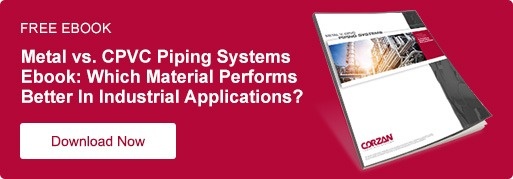How to Eliminate Pipe Corrosion in Industrial Processing Applications
This post is an excerpt from our resource article, “Metal v. CPVC Piping Systems — Can CPVC outperform metal piping in industrial applications?”
For decades, metal piping systems have been the standard choice of engineers and architects in industrial applications because of its strength and durability in high heat and pressure environments.
However, metal piping is not without its drawbacks. Specifically, if your plant uses stainless steel, carbon steel or another alloy to transport fluids, corrosion can be a real concern. Corrosion affects flow rates and efficiency, weakens pipes, and can lead to unexpected and costly shutdowns.
Conversely, pipes and fittings made with chlorinated polyvinyl chloride (CPVC) material are strong enough to withstand the high heat and pressure of industrial processes, while also being inherently inert to most acids, bases, salts and aliphatic hydrocarbons. This means the aggressive ions that attack metal molecules flow right past CPVC, leaving them and the piping unscathed.
Let’s take a look at how metal piping corrodes and why CPVC is an effective solution to eliminate this threat in industrial piping systems.
Causes of Corrosion in Metal Piping
The primary reason for corrosion in metal pipes is the type of fluid being transported.
Metal piping systems stand up fine to neutral pH water processing applications (brackish and seawater notwithstanding). However, as soon as a fluid’s pH levels extend outside of neutral levels (+/-7) or salt is introduced (e.g. brackish or sea water), metals start to corrode and can degrade relatively quickly.
Reason being, ions within acidic (pH < 7) and alkali (pH > 7) fluids, as well as saline solutions, attack specific metal elements at the molecular level, eating away at the material. This attack is accelerated when dissolved oxygen is present.
Types of Corrosion
This corrosion manifests itself in two primary ways:
Pitting Corrosion: This type of corrosion causes tiny pits to form along the length of the metal pipe, thus the term pitting corrosion. Such corrosion diminishes the pipe’s wall thickness, reducing its strength and pressure bearing capabilities.
Crevice Corrosion: A bigger cause for concern, however, is crevice corrosion. This is where fluid ions concentrate in crevices around welds, flanges and other types of pipe connections. The resulting ion buildup can degrade material more quickly, which is why when piping system leaks happen they tend to occur at the seams first.
Crevice corrosion is why there are a number of standards for welding metals, such as stainless steel pipe, as well as many welding techniques and weld finishing grades.
Consequences of Corrosion
The effects and severity of corrosion within a piping system will vary depending on the application, but generally speaking corrosion can lead to the following issues:
- Pressure rating decreases on account of thinning pipe walls.
- Flow rate can be slowed demanding more from pumps.
- Fluid purity can be contaminated as the corroded pieces float away. This is a significant concern for applications with high purity standards (e.g. semiconductor plants).
- Installation Costs will increase, as highly skilled laborers are required to weld the system. This level of craftsmanship comes at a significant cost, a cost that is increasing as the most experienced welders near retirement.
Other considerations:
- External Corrosion: A big issue for plants in coastal regions, salt content within water vapor, can eat away at a metal pipe’s exterior. In some areas, plants resort to painting external piping annually to protect its surface.
- Oxidative Layer Protection: Some metals naturally develop an oxidative layer over their surface, or additives can be applied manually to create this layer. This oxidation helps to fortify the pipe by creating armor around it that’s impervious to attack. This armor can help protect a pipe against pH levels slightly outside of neutral, extending its operating range. However, even oxidation layers can’t stand up to more aggressive acids and bases.
How to Eliminate Metal Piping Corrosion
The easiest and most effective way for most piping systems to eliminate corrosion is to replace metal systems with a material that doesn’t corrode, specifically CPVC piping, fittings and valves.
In addition to corrosion resistance, our Corzan CPVC material is engineered to satisfy the high heat and long-term pressure bearing demands of many industrial processes, delivering reliability for the life of the piping system.
Metal v. CPVC Piping Systems: Want to Learn More?
CPVC piping may outperform metal piping in terms of corrosion resistance, but how does it stack up in other categories? Check out our Metal v. CPVC Piping Systems resource page to see how the two materials compare when it comes to temperature, pressure, scaling, installed cost, lifecycle value and more. Or you can download the full article in a PDF by clicking the button below.



